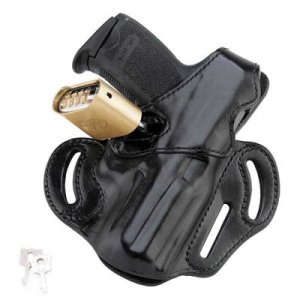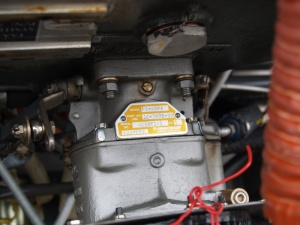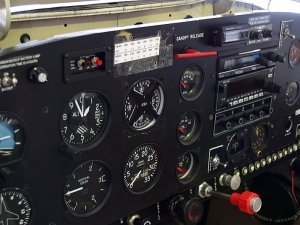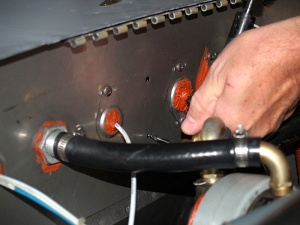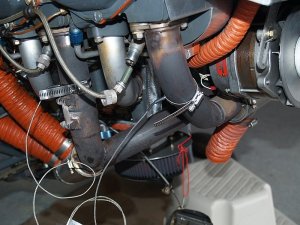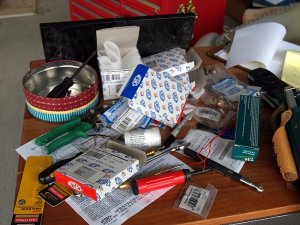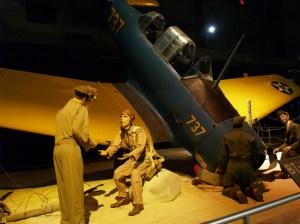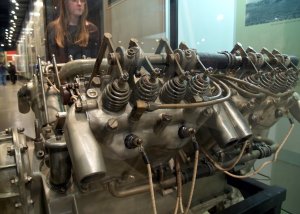…because it is most assuredly not in my nature:
Archive for March, 2008
I hope you appreciate this….
Posted in blogging on March 31, 2008| Leave a Comment »
Annual just about wrapped up
Posted in maintenance on March 30, 2008| Leave a Comment »
I replaced the broken, worn out gascolator on Saturday afternoon, and went back Saturday night (living that legendary rock star lifestyle, I am!) to prepare for Sunday’s installation of the new EGT gauge. Sometime between finishing the gascolator and returning for the preliminary EGT work, my favorite A&P had stopped by and installed the plug to seal up the gaping hole in the carburetor. While in the eyes of the FAA it would be perfectly allowable for me to have done this myself, there are some things that I feel are better left to the professionals. Drilling and tapping a hole in the carburetor fits firmly in the “have someone smarter do it” category.
The fact that drilling and tapping were required in the first place indicates to me that this plug had never been in there, and that the carb has been sucking air through that hole for at least the last few years. I strongly suspect that this will resolve the slightly rough running engine that I get at around 1400 RPM. That will be nice because 1400 RPM is a power range used almost exclusively during the turn from base leg to final while landing, which is most assuredly not a time when you want anything but a smoooooth running engine. Disconcerting, to say the least, to be low and slow and have even the most minute distrust in your engine. Easily avoided, once you know to expect it, and not really even a problem if you just slog through it, but nice to have it fixed none the less.
The simplest part of the EGT installation looked to be the actual placement of the instrument in the panel, so naturally I saved that part for myself. Four screws, and there it was:
I actually had the foresight (yeah, I’m surprised too!) to write down the color of each of the wires on the wiring harness and which wire of each of the probes that was intended to be attached to it:
Everything else was laid out and ready to go so Co-pilot Rick and I would be able to hit the ground running in the morning:
We agreed that the hardest part of the entire installation would be the process of getting the four probe wires through the firewall and back to the instrument in the panel. Not only would a hole have to be drilled in the firewall, but a shield would have to be put in place to keep the nasty stuff that goes on in the engine compartment where it all belongs: in the engine compartment. It would also be necessary to cushion the bare edges of the hole to keep the probe wires from chafing. To hold the firewall shield in place, two nutplates would have to be installed for the screws to screw into.
Sounds easy, but the cockpit side of the firewall is extremely hard to get at. To rivet the nutplates in place, we would be using blind rivets (which, as opposed to solid, driven rivets which require access to both sides of the surface, can be installed from just one side). Sort of. Someone still has to crawl up under the panel to hold the nutplates in place with the rivets are pushed through the holes. But, the first order of business is to create the holes:
The holes were pretty easily drilled, but we wanted the firewall side of the rivets to be flush with the firewall, so the holes needed to be dimpled. This is done using the same rivet puller that is used to install the rivets, but with the addition of a nifty pair of thingys that create the dimple. This operation requires that there be a person on each side of the firewall. One outside, comfortably standing on a step stool, and another on his back, scrunched up behind the panel, twisted into an ungainly and very uncomfortable position to reach up to the back of the firewall to hold the thingy in place.
You know that guy who asks you to help you move, and when you show up he points at a 100 lb. box for you to pick up, and says “I’ll hold the door?” The guy that always manages to face frontward while you pray for your life as you carefully tread backwards down the steep stairs carrying his sofa? Well, he’s also the guy that will choose to stand on the step stool, and in this case, that person is me. I swear, I’m like the guy (Marlin Perkins?) in the old TV show (I think it was ‘Wild Kingdom,’ sponsored by Mutual of Omaha): “I wait in the Jeep while Jim approaches the rabid, PMS-enraged Lioness.” Co-pilot Rick ended up on the floor of the cockpit with various pieces/parts of the floor leaving semi-permanent indentations in his back. I stood on the stool. But… we got it done:
Once the holes were dimpled and de-burred, Rick dove in again to hold the nutplates in place while I pulled the blind rivets:
To get a large enough diameter hole in the firewall, we had to resort to the Unibit. Using a Unibit is a lot like working with fiberglass: the good news is that it can drill a hole very quickly. The bad news is, of course, that it can drill a hole very quickly:
After a second trip to the Aviation Parts Department at the local Lowe’s, we were able to install a large enough grommet:
With the portal through the firewall finally being done, it was on to the much easier task of installing the probes into the exhaust pipes. The specs included with the probes direct that they be installed anywhere from four to eight inches from the exhaust flange, but those suggested specs weren’t going to work for my pipes. I had to go a little bit closer than the four inch minimum in order to work around the bent parts of the pipes and the areas where the pipes join and are double thick . The good news, though, was that the unaffordium drill bits made short work of the task. I didn’t even need the second one that I had bought:
The installation of the probes is very simple. Stick them in the hole, and tighten the hose clamp:
Trim off the excess length of the hose clamps:
We secured the cables to other parts of the engine in order to keep them from floating around in there getting themselves into trouble:
Then it’s through the firewall and attached to the wiring harness, yet another job that required someone to crawl up behind the panel. I waited in the Jeep:
Me and Marlin Perkins: we’re all about the glory, so I got out of the Jeep and did the test run to see if everything was working. All four probes worked:
I’m a little worried about the indicated temps, though. Pretty high for a mere 1500 RPM! What are they going to be like at full throttle?? This is, of course, the result of placing them too close to the exhaust flanges. Rick thinks it might be ok in flight, though, since there will be cooling air blowing across the pipes. He’s probably right, but I reserve the right to stew about it until I find out.
My nice, neat work table was showing the results of the intense installation activity, so it was time to get stuff thrown away or put away:
The final step was to use heat resistant RTV goop to stain my clothes and to keep the nasty stuff on the right side of the firewall:
All done! The plane just needs to be buttoned up and have the annual signed off and we’re ready to go! Oh, and it was Wild Kingdom.
New gascolator installed
Posted in maintenance on March 29, 2008| Leave a Comment »
Beyond being cheaper than UPS or FedEx, using the US Postal Service to have parts delivered offers an additional bonus: Saturday delivery at no extra charge. As I was pulling in the driveway on my return from Sears, where I had just purchased two expensive 3/16″ drill bits in support of tomorrow’s scheduled installation of the new EGT gauge (expensive, I believe, due to them being hand-milled from 100% unaffordium. There are some better ones made out of unobtainium, but of course they were out of those. They always are.), the mail delivery person was attempting to squeeze a 1 sq. ft. box into my 15/16 sq. ft. mailbox. Since I knew it had to be my long-awaited gascolator, I retrieved the box directly from the deliverer, foregoing my normal entertainment of sitting behind the truck enjoying the hilarity of the futile attempts to cram an oversize package into my mailbox. Saved for another day, that.
No time like the present to brave the 31F ambient, 28 wind chill and get the new part installed, so off to the hangar it was. I had anticipated a fairly expeditious installation since I saw no compelling reason to remove the existing AN fittings from the top part of the old unit; it was only the bottom part that needed replacing. A couple of things convinced me to go the whole hog, though. First, the top part of the new unit is much better looking than the old:

On the left, old and mangled. On the right, new and (should I? I will!) fangled.
The other factor was that I noticed that the fittings in the old one were on the wrong sides. The fitting where the fuel was coming in from the fuel line is plainly marked ‘out’, while the fitting that previously had the line going up to the engine mounted fuel pump is marked ‘in.’ I can tell this by the direction of the top, 90 degree fitting where the primer line was attached:
Granted, I could have simply turned the primer fitting an additional 180 degrees to get it on the other side, but see reason #1 above, and consider that this entire operation was the result of a previous application of the JOMT methodology.
The fittings were a bear to get out of the old unit, but eventually everything was all put together and mounted on the plane:
Time for a leak check. Did it leak? Well, yes, of course it did! The drain valve at the bottom of the cup turned out to only be hand tightened, so a quick dose of wrench grease fixed it right up.
And now, simply because I can’t help myself, I present old & mangled, new & fangled, and temptingly dangled:
No, I won’t blame you for never coming back after that one!
A number of updates…
Posted in canoe, maintenance, Miata, shooting on March 27, 2008| 2 Comments »
As a public service for those readers that I just know are on the edges of their seats wondering about the status of various open issues, I hereby present a collection of updates:
– the Canoe Project: when I last spoke on this topic, I was at a loss as to how to get the lower and upper side panels to meet. I’m not so worried about the gap between the two; the bigger issue is that I can’t get them flush. My efforts to rectify that had been concentrated on getting the lower panel to move inward to match the edge of the upper panel, but no amount of coercion could convince it to do so. I was down in the Boatworks a few days ago on an unrelated mission, and took the opportunity to take a fresh look at the problem. Now I grant you, this is going to seem painfully obvious in hindsight, but it appears that it will be quite easy to shim the upper panel away from the temporary bulkhead such that it moves outboard enough to line up with the lower panel. Yeah, like I said: “Duh!”
– the Miata: if you recall, it nearly left me stranded clear across town when the clutch wouldn’t disengage enough to allow me to get it into gear. I made an adjustment to the length of the clutch pushrod in order to get home, then stuffed the car back in the garage behind the snow plow and decided to just leave it there until, well, yesterday afternoon. I figured that maybe it was low on clutch fluid, so the first thing I did yesterday was pop the hood and check the level in the translucent plastic fluid reservoir. Which, thankfully, wasn’t back in the trunk with the battery. The level appeared to be mid-way between the Min and Max marks, but since I had needed a jump start again to get it started, I figured I could eradicate two avians with one projectile with a drive to the auto parts store to secure a container of DOT 3 brake/clutch fluid, which would also serve to push a new reserve of electrons into the battery. When I got back, I popped the lid on the reservoir, only to find it nearly bone dry. The reservoir was stained with the remains of fluid past, which presented a false level reading when viewed from the outside. Sigh.
– the Annual Condition Inspection: still waiting on the new gascolator. I ordered a new one from Aircraft Spruce last Friday, but cancelled the order when I received a very generous offer from an RV builder that had a gascolator that he would not be using. Many of you that attend Oshkosh each year will recognize the name of the donor, Mr. Bob Collins, as the driving force behind the annual BBQ. I had to renew the order for what turns out to be my old Model GAS-1 gascolator once I found out that the donated gascolator, a Model GAS-5, won’t fit the mount on my plane. That’s unfortunate because the newer model is much nicer than the old one, but I don’t want to have to refabricate the mount, at least not in the short term. Maybe when I replace the oil and fuel hoses later this year, though. In any event, thanks Bob!
– Shooting with my brother: finally having had all I can stand of the emasculating effect of showing up with .22 rimfires as he pulls out his gazillion caliber bazookas, I decided that I needed a grown-up rifle. But… I don’t hunt. I just like to make the thing go bang, and I like the mechanical precision of firearms. I enjoy the challenge of trying to consistently hit a target, and I like the congeneality I share with my brother when we have co-interests. With that in mind, you won’t be surprised to learn that I wasn’t keen on the idea of spending $600 – $800 for a new rifle. I have a friend at work that collects old military surplus guns, and he suggested that I look for one of those. I decided on a Chinese SKS. They’re commonly available at gun shows, moderately priced, and parts/ammo are cheap and also commonly available. I took it out and shot ten rounds through it last week to make sure it works, and found that it’s more pleasant to shoot than I had expected. It jumps a bit when you shoot it, but there is very little recoil that gets as far as your shoulder. In other words, you can shoot it all afternoon and not come home sore and/or bruised. I took a few pictures of it, if you’re curious:
http://picasaweb.google.com/HogarthKramer/SKS
It has a ten round internal magazine that loads through the top, but that’s kind of a pain in the nethers to do. I ordered a 20 round removeable magazine to replace it, and I found that it is much easier to load. Worth the $18. Oh, and if you must know, the gun itself was $265. They can be had far cheaper, but most of them at that price point look pretty ratty and run-down.
F1 – Malaysia Practice Lap
Posted in Uncategorized on March 22, 2008| Leave a Comment »
I always like to get at least a few laps in at whatever track Formula One is racing at before watching the race. That way, I can say “Huh, I crashed at that turn too.” Helps with the self-esteem.
Anyway, the Malaysian Grand Prix is tomorrow, and here are a couple of my practice laps:
For comparison, here’s the real thing:
Update:
There was a question in the comments as to where I get Formula One on TV. Out local cable provider carries Speed TV, who in turn carries Formula One.
JOMT methodology extends annual
Posted in maintenance on March 22, 2008| 2 Comments »
I went out to the hangar to start re-attaching pieces-parts to the airplane as the annual condition inspection wraps up. I fixed the droopy exhaust pipe yesterday, the droopiness of said exhaust pipe having been the cause of the rubbing between the heat cuff and the side of the cowl. The exhaust pipe hangs from a 1″ Adel clamp attached to what must be a slightly less than 1″ diameter piece of the engine mount. Because the clamp wasn’t tight, it was unable to keep the exhaust pipe up where it belonged. I removed the old clamp, which turned out to be a royal pain because of its location. Apparently the builder had used black electrical tape wound around the engine mount as a spacer to give the clamp something to grab onto, but the tape had become brittle and eventually slid out from under the clamp. Long story short (too late!), I used a piece of heat resistant nylon tubing for the same purpose, and the exhaust pipe is now secure.
I put the spark plugs back in this evening, and was going to call it a day when I decided to go ahead and put the gascolator back on. I’m been having a problem with the threaded knob that holds it in place being difficult to remove and replace, and today was no different. I got it as tight as I could, but when I turned on the fuel pump to leak test it, I found that it still leaked. This is when I decided to apply the JOMT (Just One More Turn) methodology, and as is usually the case, I went one turn too many. I broke the threaded knob thingy. Crap. Had to order a whole new gascolator, and now I have to wait for it to arrive next week. On the plus side, the old one was kind of worn, and a new one will be nice to have.
As long as I was placing an order, I also ordered some new screws to replace some of the ones that were reluctant to come out this time. I hate messing around with worn out screws that require a fight to remove or replace, and since they only cost a few cents each, it’s worth a few bucks now and then to replace them.
Travels with Egg
Posted in Copilot Egg, Photos on March 21, 2008| Leave a Comment »
Co-pilot Egg is out of school for the week for the so-called Spring Break. Being 14 and all, she hasn’t the Caribbean option for recreational activity, so is stuck here in sunny Columbus for the duration. I try to take at least one day off during her sojourn in order to make our annual-when-we-think-of-it trip to the US Air Force Museum in Dayton.
I like to take my camera, but it usually turns into an exercise in futility. There is very little light in the museum, and what little there is is usually yellow. Because it’s so dark, the flash on the camera can’t do an adequate job of lighting the entire airplane, and because of the color, everything ends up with a wicked tint. Here’s an example:
(Reminder: click on picture for larger view!)
There wasn’t much that I could do to get a useful picture out of that in color, so I made it black & white and added some grain to it:
That turned out fairly well, but only because of the nature of the subject. I wouldn’t want to do them all that way. What I decided to try instead was to bring the tripod with us, and use it to hold the camera steady enough to allow the use of a much longer shutter speed. With a long enough shutter speed, the ambient light should be enough to light the entire airplane. That worked for the most part, but I found a new problem right away: the pictures all had an overall deep tint of orange or blue to them, depending on the type of lighting the museum had selected for any particular exhibit. My camera has a selectable/customizable white balance, though, so I experimented with different settings until I got what appeared to be acceptable results in the LCD screen:
Egg liked this one because it’s purple/pink:
I’m considering getting a parachute for Brave Sir Hogarth after seeing this:
A challenge to photography equally difficult to the lighting issue was the schedule Egg was enforcing to ensure that we weren’t late to the Imax movie (one of our annual events), so I didn’t stop to read the placard to learn exactly why a dog needed a parachute. Later Google research explains it:
BERLIN AIRLIFT DOG PARACHUTE
This parachute was specially made for “Vittles,” a dog that flew 131 missions with his owner, 1Lt. Russ Steber, during the Berlin Airlift. Gen. Curtis LeMay named the dog and ordered the parachute made for him. Vittles, a boxer, accumulated around 2,000 flying hours, but never had to use the parachute. His owner, Lt. Steber, did have to bail out of a C-47 over the Soviet zone on one occasion, but Vittles was not with him on that trip. Steber was captured and returned to the West a few days later.
So there ya go. Of course, without the use of opposing digits (i.e. thumbs), I’m not sure how old Vittles was expected to pull a rip cord.
We also visited one of the airplanes that I worked on when I was in the Air Force:
We also found time to visit some of the more interactive displays:
I used my new flash for these since it did a much better job of filling the light. Here’s the same picture from two years ago using a lesser flash:
Egg is trying to perform a spacewalk using a rocket backpack- you’d look intense too: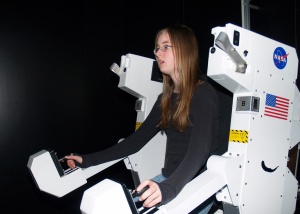
There are more pictures, of course. You can see them here:
For the dog what has it all…
Posted in Brave Sir Hogarth on March 19, 2008| 1 Comment »
Every now and then I feel pangs of guilt (tiny, little, itsy-bitsy pangs, but pangs none the less) that Brave Sir Hogarth has been unable to fly with me since I selfishly traded the larger Tampico for the far less voluminous RV. Maybe a gadget like this would make it up to him:
I know I would benefit from it. No, not by increasing my abysmal excercise quotient; it would give him something to do other than constantly dropping a wet, smelly, slobber-coated ball in my lap on the rare occasions when I try to watch TV. The gravitas of Mr. John Adams, for example, suffers grievously when a juicy Kong Ball gets plopped into my crotch. Trust me.
I don’t know why we don’t just get rid of the thing. The ball, not the canine companion, that is. It’s supposed to help keep his teeth clean and his breath sweet and fresh, but the breath thing is apparently relative. I suppose regular dog breath is pretty nasty, but the ministrations of the Kong Ball cause it to smell like the inside of that abandoned tire you found out in the woods. Or the inside of a really old diving suit. Ick. Maybe he’s using it wrong – he’s never been big on reading the instructions, as you can imagine.
Of course, he’s hopelessly devoted to it and would miss it terribly if we were to dispose of it. I’ve tried hiding it, but he mopes until he finds it. He likes to leave it out in the middle of a room, which presents an ankle twisting opportunity for the guy that leaves the house for work while it’s still dark, so it has to be put in a corner. He resents having his toys moved, so often puts it right back in the center of the room. There are only two sentences that Hogarth understands: “Do you want to go outside,” and everything other thing spoken to him. The first he understands as we would. The rest all translates in his mind as “go get your ball.” Except for one exception: “Go get your ball” seemingly translates as “stand there and look stupidly at me.” I appreciate the irony of that.
Anyway, I think he’d really love having a machine to throw the ball for him, although I suspect the noise of it would drive me batty. I’ll wait for the New & Improved version.
The Annual Saga – light at the end of the… airplane
Posted in maintenance on March 18, 2008| 2 Comments »
This burned out tail light continues to torment, irritate, and generally frustrate me. As I mentioned previously, I was not the one to first notice its failure to operate. I also alluded to a rather uncomfortable encounter at the airport resulting from its untimely demise.
It’s a long story, but the gist of it is that we were at the point in the engine class where we were to be trained on the procedure for testing the compressions on the cylinders. This is an operation performed at every annual inspection whereby compressed air (to the tune of 80 psi) is introduced into a cylinder via one of the spark plug holes. A pair of gauges are attached to the air hose, and between the two of them a differential is determined that indicates the health and well being of the valves and piston rings. A perfect cylinder would not leak at all, so it would achieve a score of 80/80. The Tampico, with its high time engine, scored moderately concerning 68s and 69s. The stable horses at the school were lucky to see something deplorable in the mid 50s.
My brilliant plan was to being Papa Golf over to the school to check the compressions using their equipment and training. The annual was coming due anyway, and it’s only a very short taxi from my hangar to the gate at the back of the school hangar. What could go wrong?
Well, I failed to do an adequate preflight because, well, I wasn’t going to fly. That doesn’t matter, of course, because the lighting regulations stipulate that I have operating night lighting any time I am moving the aircraft after dark. Mea culpa, and I freely admit it. So, the arrangement I made was that I’d go over and get the plane, and one of the other students would use a flashlight to guide me past the FedEx 727 parked just outside the school hangar as I got to the gate. The plan was working flawlessly, until I was just about to the gate. Concerned that the incredibly bright strobes would be too blinding for the guide, I turned them off just as I got to the gate. About 5 or 10 seconds later, a car behind me on the taxiway flashed his headlights at me. Assuming that I was in his way (not that he had the right of way, mind you, but simply as a courtesy) I pulled over by the entrance to the taxiway and shut down.
I climbed out and was coordinating the next steps with the other student when the driver of the car pulled up and stopped. Now, in my opinion, there are two ways to point out to someone that the little white light bulb at the back of his plane is burned out:
#1: “Excuse me, did you know that your tail light is burned out?”
#2: Roll into a ten minute diatribe laced with the oft-observed fact that I am a copulating sphincter (anatomically speaking, that is. One would probably use the more common vernacular) and other choice observations having to do with parental lineage and general lack of worthiness to inhabit our planet.
As you may have guessed, #2 was the chosen method. It had to be the most awe-inspiring over-reaction I’ve seen in a long, long time. Silda Spitzer couldn’t have topped it, and she actually had cause. At one point, the other student was moving into place behind him in case he needed to be restrained. Seriously. Keep in mind, the other nav lights were on and working, as were the strobes. Yes, I should have checked the lights before taxiing the airplane, but this was just ridiculous.
In any event, he finally wore himself out and jumped back in his convertible BMW (and we all know how those people are, don’t we? [inside joke]) and left the premises.
On the plus side, my compressions came in at 78, 78, 78, and 79. Good engine!
So, now I’m trying to order a replacement light bulb. I stopped by the hangar on the way home from work to remove the old one and get a part number to order a replacement. I couldn’t read the tiny little letters on the bulb, so I brought it home for Co-pilot Egg to read. She proudly pronounced it to be part number ‘ERC’, which inconveniently enough is not listed in any of my catalogs. Drat! I ran back to the airport to catch the mechanic before he left for the day, figuring he’d have a larger collection of catalogs. I confessed to him that my old eyes couldn’t read the number on the bulb. He said that I didn’t have to; it’s written right on the light fixture. Oh, the embarrassment! Sure enough, I went back to the hangar and there it was plain as day.
“Oh well,” I thought, “might as well get it on order. It shouldn’t cost much.”
Here comes the insult that naturally follows just about every injury, or vice-versa:
$22.20 for that little, tiny bulb. Plus shipping.
Is it any wonder that more people don’t fly?
But, on the other hand, remember the mysterious hole in the carburetor? It will be filled thusly:
$1.47. From a car parts store. What would it cost if it was an official airplane part? The sky’s the limit, so to speak.

